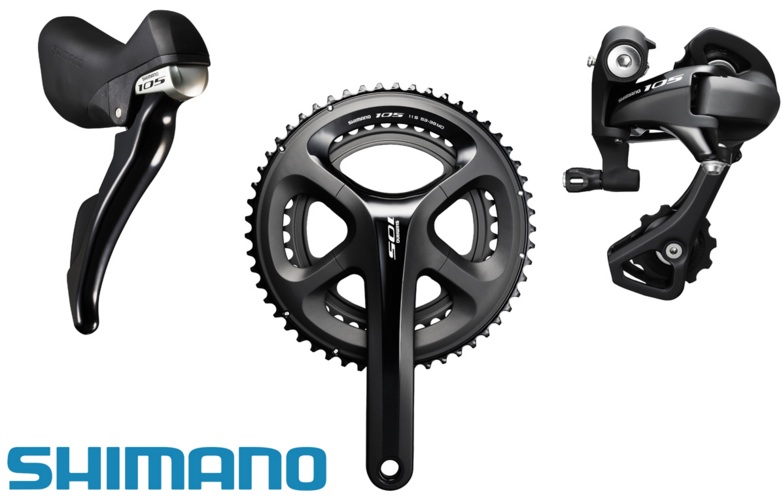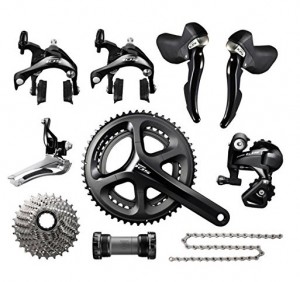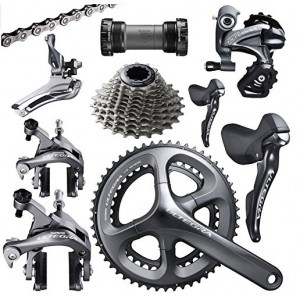
There’s lots of bike components out there, but walk into an average bike shop, and you’ll likely be offered a choice between two groups, the 105 and Ultegra, both of which are manufactured by Shimano. Bike shops often carry a majority of these two because they’re mid-range in price and entry-level, but still offer the status needed to compete and are reliable recreation riding.
Shimano is Everywhere
Shimano product sales constitute about 50 percent of the global bicycle component market. It’s the most prevalent supplier of bike components worldwide, but there are others. The hierarchy of brand names include SRAM, based in the United States, and Campagnolo, based in Italy.
It’s a Price Thing
Price is the biggest decision maker when choosing a bike. It’s one thing to say that you want the best. But the reasons to compare 105 and Ultegra go beyond that. The price difference between 105 and Ultegra is about $300 dollars. The price jump from the mid-range Ultegra to the high dollar Dura Ace is a whopping $700 or more.
Full Groups
You’ve probably heard bike shop salesmen state that a given bike is full Ultegra, or full 105. This means that the bike has been priced accordingly, and contains all the components from the stated group. In this case, a full 105 bike should be priced lower than a full Ultegra.
Recreational 105
Think of the 105 group as an entry-level component. It’s capable of racing, but cheaper. Lots of first-time racers run their first races using 105. If they like racing, and plan on doing more of it, then moving up to Ultegra is the next step up. If racing was a one-time fling, the purchase of 105 was the right move.
What 105 is Not
The 105 group is not a department store component. Shimano produces cheaper components for department store bikes. Sora and Tiagra, both lower on the tier than 105, are targeted more for entry level bikes or even department store bikes.
Ultegra Character
Ultegra has the status and performance required to be on a racers list, but not so spendy that it’s not appropriate for recreational riding as well. It’s not the high-priced racing gear of the professionals, who might go with Shimano Dura-Ace, SRAM red or Campagnolo super record, but it’s still got what it takes to win races.
Differences are Valid
The performance differences between 105 and Ultegra might seem subtle to the average cyclist, but they’re valid. It comes down to weight, engineering, performance and maybe a bit of cosmetics.
Shifter Handles
Cosmetically, Ultegra boasts a carbon shifter blade, while the 105 sports an aluminum blade. On the inside, Ultegra’s lighter, harder parts, higher quality bushings and springs make for overall better feel when operating the brakes or shifting the bike.
Subtle Shifting
If you’re new to cycling, you might not notice the differences in shifting. Even though subtle, Ultegra shifts with a slightly cleaner feel than 105, which can seem to have a robotic click, instead of a smooth transition. Again, it’s subtle, and virtually unnoticeable to the untrained cyclist.
Brakes
Braking power on both models is more than enough to get you stopped fast. Neither one claims the top spot for reliability, but 105 may be noisier than Ultegra. Better quality springs on the Ultegra, and in this case, pivots, allow for more braking power than 105. Brake pad quality is another significant factor in the performance of Ultegra brakes over 105.
Drivetrain Specs
With chains and cassettes, the differences between 105 and Ultegra are slight but still affect performance. Ultegra has a nickel-like finish on the chain, and a stronger riveting process that allows for a stiffer chain. The chain on a 105 chains has a duller finish, and due to a different riveting process, are more stretchy than Ultegra. An Ultegra cassette substitutes the aluminum lock ring for the steel one found on a 105. The machining on the aluminum cogs of an Ultegra cassette are held to tighter tolerances than 105.
Up Front
The Ultegra crankset is hollow. The Ultegra chainring shape blends nicely into the body of the Ultegra crankarm. The overbuilt structure of the crankset coupled with the chainring has better power transfer over the 105, which doesn’t sport a hollow outer chainring.
Trickle Down
It’s common for Shimano to introduce new engineering every few years. The previous years engineering advancements trickle down to the lower tier, meaning that the Dura Ace from last year, is now identified as a contemporary Ultegra. The trickle down engineering advantage is more likely to be found on Ultegra, than 105.
Basic Machining
New engineering means that Ultegra, for example, is machined to a higher degree than 105. The same goes for the brakes, shifters and drivetrain.
Stiffer
New designs and finer machining typically go hand in hand with new alloys that are stiffer, meaning that the parts on an Ultegra are lighter than the parts on a 105.
Lighter Not Always Better
It’s not always best to go with the lightest components. The lighter they get, the more delicate they are. In some instances, such as in dirty conditions, the 105 may be able to withstand more punishment, just because it’s heavier, and more substantial.
The Breakdown
 105
105
- Complete group weighs just under 6 lbs.
- Entry level, recreational, but is race capable.
- Reliable, maybe even more so when dirty or wet
- Cheaper to repair or replace
- Available in 11 speed, but more likely only 10.
 Ultegra
Ultegra
- Weighs in over a 1/2 pound less than 105 at 5.38 lbs.
- Race level performance
- Cleaner shifting and braking, subtle but noticeable.
- 11 speed more likely than 105
Wheel Advantage
It’s already been established that that spending $300 dollars more for Utegra saves weight, and theoretically makes your bike faster and more efficient. But there’s another way to accomplish the same thing, and some cyclists say with better results. Cyclists on a budget can often save more weight on wheels.
It can make sense to purchase 105, and invest the $300 in racing wheels. It might even be possible to talk the bike shop owner into swapping out the wheels on the 105 before purchase. It’s an option worth considering.